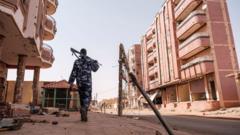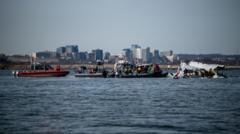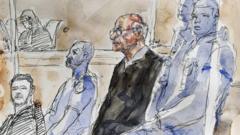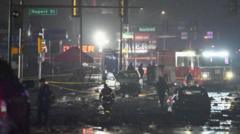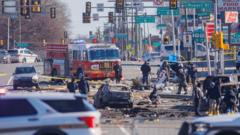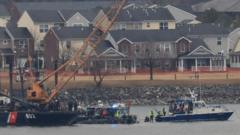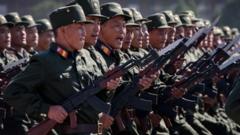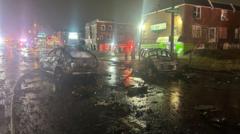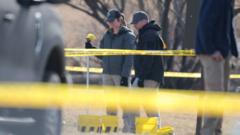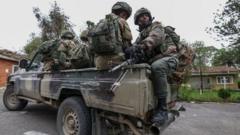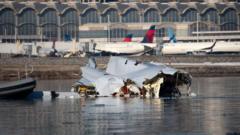Following the tragic plane crash in South Korea, attention has turned to an unusual concrete wall near the runway. Aviation experts suggest that this structure may have contributed to the disaster, leading to critical evaluations of safety standards and airport design.
Unraveling the Mystery of the Wall: Insights into South Korea's Devastating Plane Crash
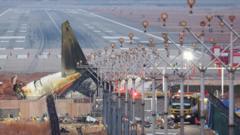
Unraveling the Mystery of the Wall: Insights into South Korea's Devastating Plane Crash
Investigators probe the role of a concrete wall at Muan International Airport in a crash that claimed 179 lives, raising questions about aviation safety protocols.
Article Text:
In the aftermath of the tragic Jeju Air crash at Muan International Airport, which resulted in the deaths of 179 individuals, aviation experts are scrutinizing an unusual concrete wall situated near the runway. Footage reveals that the aircraft veered off the runway, colliding with the wall before erupting in flames. Experts are particularly focused on the wall's placement, which is approximately 250 meters (820 feet) beyond the runway's end.
David Learmount, an air safety expert, emphasized that the presence of this "obstruction" may have severely impacted the outcome of the crash. He noted that, had the wall not been there, “most — possibly all — those on board would still be alive.” The plane encountered a bird strike and subsequently aborted the landing, opting instead to approach from a reversed direction. Reports suggest that the plane landed heavily, lacking wheels or gear, yet according to Learmount, the manner of landing itself was executed as well as could be expected under such circumstances.
The 4-meter high concrete structure, which supports a navigation system essential for aircraft landings, has sparked concerns given that similar installations at other airports are often made to be more forgiving in terms of impact. According to South Korean authorities quoting Yonhap News Agency, the wall was erected to maintain the localiser's level with the runway for functionality. Nonetheless, the Ministry of Transport is now evaluating whether such structures should be constructed with materials designed to break upon impact.
Lufthansa pilot Christian Beckert called the presence of the rigid structure "unusual," indicating that standard airport protocols typically do not permit hard obstacles directly past runway ends. Chris Kingswood, another seasoned pilot, echoed this sentiment, noting that recent industry standards require such structures to be "frangible" to minimize the risk of catastrophic damage were an aircraft to strike them.
Adding to the complexities of the incident, aviation analyst Sally Gethin questioned whether the pilots were even aware of the wall, especially as they approached from a non-standard landing path. The investigation continues to delve into the events leading to the tragic crash, awaiting findings from the flight data recorders to answer outstanding questions about decision-making and situational awareness during the landing attempt.
In the shadow of this incident, the aviation community is reminded of the importance of rigorous safety standards and the implications that design features such as the wall may have on passenger safety. The outcomes of this unfolded tragedy may influence regulations at airports both in South Korea and globally as stakeholders work to prevent a recurrence of such a catastrophic event.
In the aftermath of the tragic Jeju Air crash at Muan International Airport, which resulted in the deaths of 179 individuals, aviation experts are scrutinizing an unusual concrete wall situated near the runway. Footage reveals that the aircraft veered off the runway, colliding with the wall before erupting in flames. Experts are particularly focused on the wall's placement, which is approximately 250 meters (820 feet) beyond the runway's end.
David Learmount, an air safety expert, emphasized that the presence of this "obstruction" may have severely impacted the outcome of the crash. He noted that, had the wall not been there, “most — possibly all — those on board would still be alive.” The plane encountered a bird strike and subsequently aborted the landing, opting instead to approach from a reversed direction. Reports suggest that the plane landed heavily, lacking wheels or gear, yet according to Learmount, the manner of landing itself was executed as well as could be expected under such circumstances.
The 4-meter high concrete structure, which supports a navigation system essential for aircraft landings, has sparked concerns given that similar installations at other airports are often made to be more forgiving in terms of impact. According to South Korean authorities quoting Yonhap News Agency, the wall was erected to maintain the localiser's level with the runway for functionality. Nonetheless, the Ministry of Transport is now evaluating whether such structures should be constructed with materials designed to break upon impact.
Lufthansa pilot Christian Beckert called the presence of the rigid structure "unusual," indicating that standard airport protocols typically do not permit hard obstacles directly past runway ends. Chris Kingswood, another seasoned pilot, echoed this sentiment, noting that recent industry standards require such structures to be "frangible" to minimize the risk of catastrophic damage were an aircraft to strike them.
Adding to the complexities of the incident, aviation analyst Sally Gethin questioned whether the pilots were even aware of the wall, especially as they approached from a non-standard landing path. The investigation continues to delve into the events leading to the tragic crash, awaiting findings from the flight data recorders to answer outstanding questions about decision-making and situational awareness during the landing attempt.
In the shadow of this incident, the aviation community is reminded of the importance of rigorous safety standards and the implications that design features such as the wall may have on passenger safety. The outcomes of this unfolded tragedy may influence regulations at airports both in South Korea and globally as stakeholders work to prevent a recurrence of such a catastrophic event.

